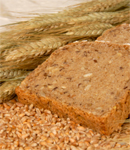 Flour has been a staple of the North American diet since the continent was first populated with people. For the past century, wheat flour has dominated the commercial market. Everything we buy that contains flour — from bread, to cereals, to pasta — is usually made from this flour. And, while flour made from wheat grain can be nutritionally healthful, many people are now developing sensitivities from overconsumption.
Flour has been a staple of the North American diet since the continent was first populated with people. For the past century, wheat flour has dominated the commercial market. Everything we buy that contains flour — from bread, to cereals, to pasta — is usually made from this flour. And, while flour made from wheat grain can be nutritionally healthful, many people are now developing sensitivities from overconsumption.
To overcome the problems of wheat sensitivity — that can include symptoms as far-ranging as headaches, brain fog, and digestive troubles — it may be time to consider using other types of flour. There are a surprising number of different ways to make a flour base that can be used in the preparation of all your favorite foods. Let’s take a look at your best and healthiest options:
1. Buckwheat flour has a dark, nutty flavor and is gluten-free. It’s packed with nutrients and makes a great substitute for wheat flour when making breads, pancakes and muffins. Buckwheat is readily available now in most stores.
2. Rice flour is a form of flour made from finely milled rice. It can be made from either white or brown rice. Brown rice flour contains a number of healthful nutrients. It is usually combined with other flours when baking, as it has a dry, crumbly texture when cooked.
3. Spelt flour is one of the most popular and widely available of alternative baking flours. Spelt is actually part of the wheat family of flour, but its fats are more soluble and the nutritional content higher than wheat flour. Spelt flour has a nutty and slightly sweet flavor similar to that of whole wheat flour and for that reason it’s a great choice for those who want to try something different, but want almost the same texture and taste as wheat flour. Spelt flour does contain gluten, however.
4. Teff is a tiny grain that is packed with nutrition. It’s higher in protein than wheat and has a high concentration of nutrients, including calcium, thiamin, fiber and iron. The iron from teff is easily absorbed by your body. Teff is thought to benefit people with diabetes, as it helps control blood sugar levels. Teff contains no gluten, which makes it ideal for people with celiac disease or with wheat sensitivities. It’s also popular with athletes, as it seems to boost energy levels.
You can also buy flour made from beans, such as pinto and chickpea. These flours are surprisingly tasty and tend to be high in fiber and protein. Root vegetables can also be made into flour — the most common of which is potato flour. Give them all a try.
One health tip about storing flour: put a bay leaf in the flour canister to help protect against insect infections. Bay leaves are natural insect repellents.
To find out how these whole grain flours could protect against heart disease, read this article.
